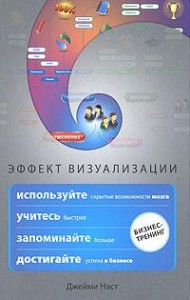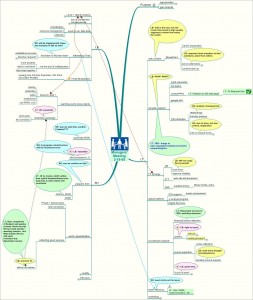“Idea Mapping” in Russian
Idea Mapping No Comments »I was thrilled to learn that Jamie Nast’s book “Idea Mapping” was translated into Russian. OZON.ru, one of the most popular online booksellers in Russia that is using business model similar to Amazon.com (they even sound similar, or almost similar, don’t you think?), posted a customer review that I thought had failed to do the book justice. After reviewing a Russian copy of the book, which in my opinion was very well translated, I wrote and posted my review (text below) giving the book – with a glee – 5 stars that it deserves.
Книга очень полезная. Я не согласна с автором предыдущего отзыва, что «вся книжка – авторская самореклама». Я знаю Джейми больше пяти лет (я участвовала в её семинарах) и могу из собственного опыта подтвердить, что синдромом самопродвижения она не страдает. Напротив, Джейми использует свою энергию и признание, как ведущий авторитет в этой области, на то, чтобы помочь людям овладеть навыками визуализации мыслей и идей и улучшить их работоспособность.
Я ознакомилась с русским переводом книги после прочтения оригинального издания и мне кажется, что, не смотря на хороший перевод и соответствие оригиналу, не всё поддаётся дословному переводу. Например, idea mapping в переводе на русский дословно звучит как картирование идей, и для меня это звучит довольно странно и не органично, чего нельзя сказать о терминологии в английском варианте. Я допускаю, что подобные лингвистические нюансы могут привести к не совсем полному пониманию задачи поставленной книгой.
Визуализация мыслей и идей с помощью схем и карт не является достижением нашей эпохи, уходя корнями в историю. В современном мире заслуга разработки теории ментальных карт принадлежит Тони Бьюзену. Заслуга Джейми заключается в том, что она упростила метод и правила лежащие в основе теории Бьюзена, давая «ментальным картографам» больше творческой свободы и возможности самовыражения. Такой подход делает книгу незаменимым практическим руководством для всех тех, кто ищет новые пути по улучшению своих умственных способностей, развитию памяти и повышению продуктивности и успеха в делах.
Особенность ментальных карт заключается в том, что они отражают естественную работу мозга, в частности его ассоциативную природу. С помощью ключевых слов, простых рисунков и разноцветных маркеров, ментальные карты помогают систематизировать мысли и придумывать новые идеи. Успех многих компаний и бизнесов во многом зависит от творческого потенциала работников и служащих. Система Джейми помогает развить и увеличить творческую активность и изобретательность людей, и потому её семинары пользуются большой популярностью в корпорациях, учебных заведениях и среди частных лиц.
Книга преподносит материал с элегантной простотой, что нельзя путать с упрощённостью, используя многочислкнные примеры и иллюстрации. Большим достоинством книги является то, что Джейми делится с читателями образцами карт созданными людьми из разных сфер деятельности, давая возможность начинающим «картографам» ознакомиться с реальным применением этого метода в разных жизненных ситуациях. Конечно, надеятся, что читатель мгновенно поумнеет после прочтения книги, это наивно. Как любой инструмент, этот метод требует практики, и книга Джейми послужит вам хорошим путеводителем.

![[blinklist]](http://powermapping.ideamappingsuccess.com/IdeaMappingBlogs/wp-content/plugins/bookmarkify/blinklist.png)
![[BlogMarks]](http://powermapping.ideamappingsuccess.com/IdeaMappingBlogs/wp-content/plugins/bookmarkify/blogmarks.png)
![[Blogsvine]](http://powermapping.ideamappingsuccess.com/IdeaMappingBlogs/wp-content/plugins/bookmarkify/blogsvine.png)
![[del.icio.us]](http://powermapping.ideamappingsuccess.com/IdeaMappingBlogs/wp-content/plugins/bookmarkify/delicious.png)
![[Digg]](http://powermapping.ideamappingsuccess.com/IdeaMappingBlogs/wp-content/plugins/bookmarkify/digg.png)
![[diigo]](http://powermapping.ideamappingsuccess.com/IdeaMappingBlogs/wp-content/plugins/bookmarkify/diigo.png)
![[Facebook]](http://powermapping.ideamappingsuccess.com/IdeaMappingBlogs/wp-content/plugins/bookmarkify/facebook.png)
![[Jeqq]](http://powermapping.ideamappingsuccess.com/IdeaMappingBlogs/wp-content/plugins/bookmarkify/jeqq.png)
![[Ma.gnolia]](http://powermapping.ideamappingsuccess.com/IdeaMappingBlogs/wp-content/plugins/bookmarkify/magnolia.png)
![[Mister Wong]](http://powermapping.ideamappingsuccess.com/IdeaMappingBlogs/wp-content/plugins/bookmarkify/misterwong.png)
![[Netvouz]](http://powermapping.ideamappingsuccess.com/IdeaMappingBlogs/wp-content/plugins/bookmarkify/netvouz.png)
![[Newsvine]](http://powermapping.ideamappingsuccess.com/IdeaMappingBlogs/wp-content/plugins/bookmarkify/newsvine.png)
![[Propeller]](http://powermapping.ideamappingsuccess.com/IdeaMappingBlogs/wp-content/plugins/bookmarkify/propeller.png)
![[Reddit]](http://powermapping.ideamappingsuccess.com/IdeaMappingBlogs/wp-content/plugins/bookmarkify/reddit.png)
![[Slashdot]](http://powermapping.ideamappingsuccess.com/IdeaMappingBlogs/wp-content/plugins/bookmarkify/slashdot.png)
![[Sphinn]](http://powermapping.ideamappingsuccess.com/IdeaMappingBlogs/wp-content/plugins/bookmarkify/sphinn.png)
![[StumbleUpon]](http://powermapping.ideamappingsuccess.com/IdeaMappingBlogs/wp-content/plugins/bookmarkify/stumbleupon.png)
![[Technorati]](http://powermapping.ideamappingsuccess.com/IdeaMappingBlogs/wp-content/plugins/bookmarkify/technorati.png)
![[Twitter]](http://powermapping.ideamappingsuccess.com/IdeaMappingBlogs/wp-content/plugins/bookmarkify/twitter.png)
![[Email]](http://powermapping.ideamappingsuccess.com/IdeaMappingBlogs/wp-content/plugins/bookmarkify/email.png)





